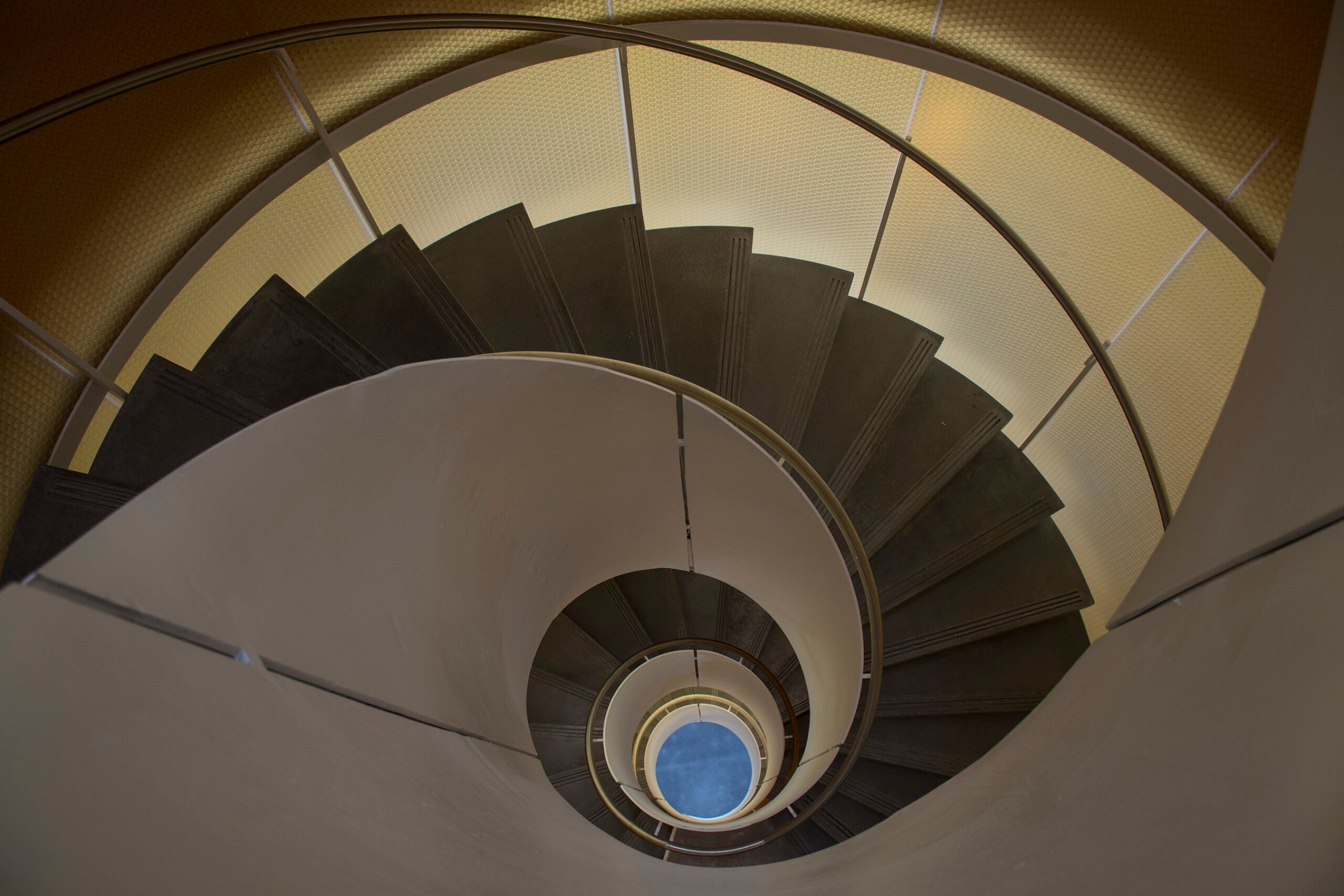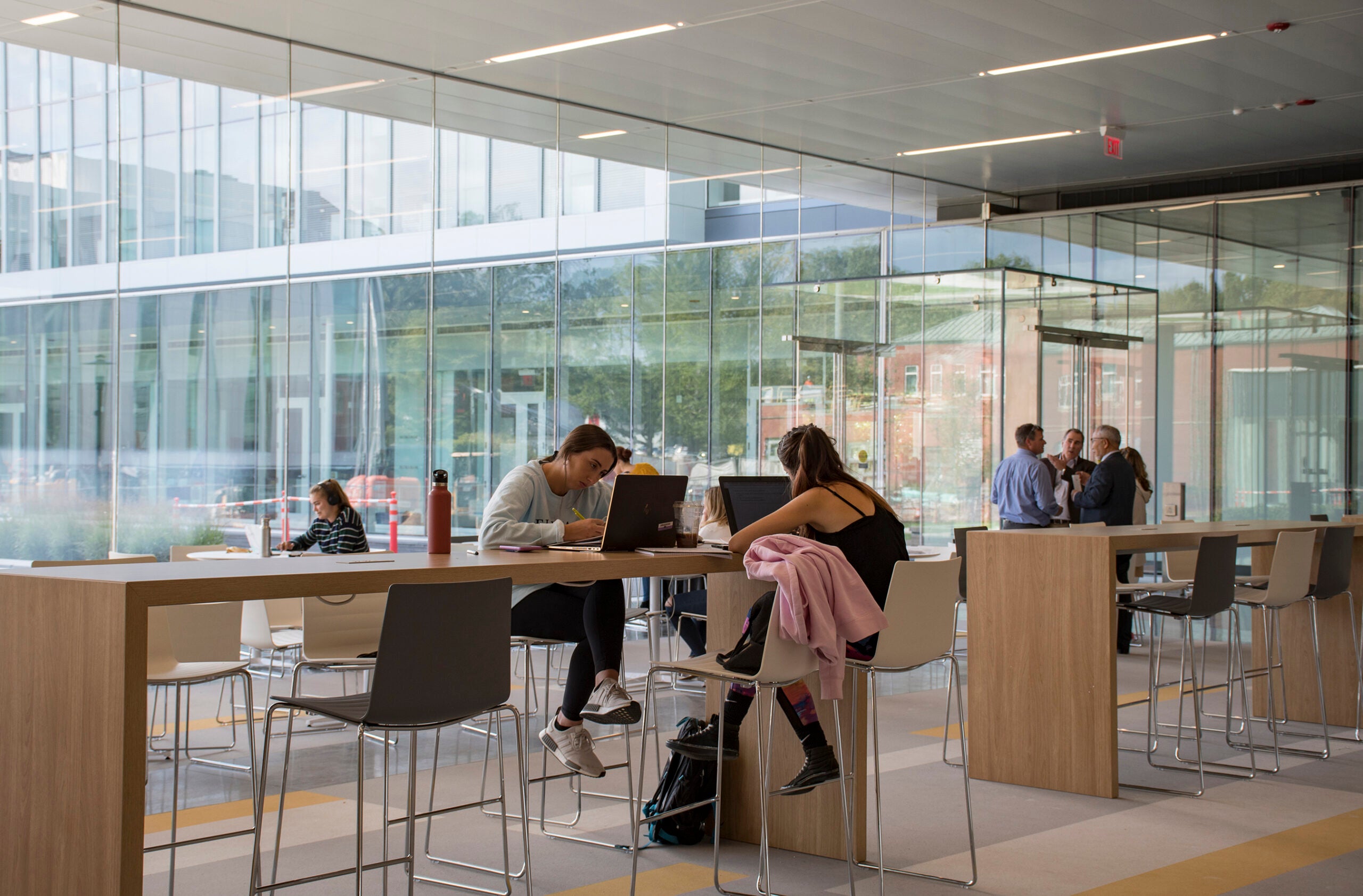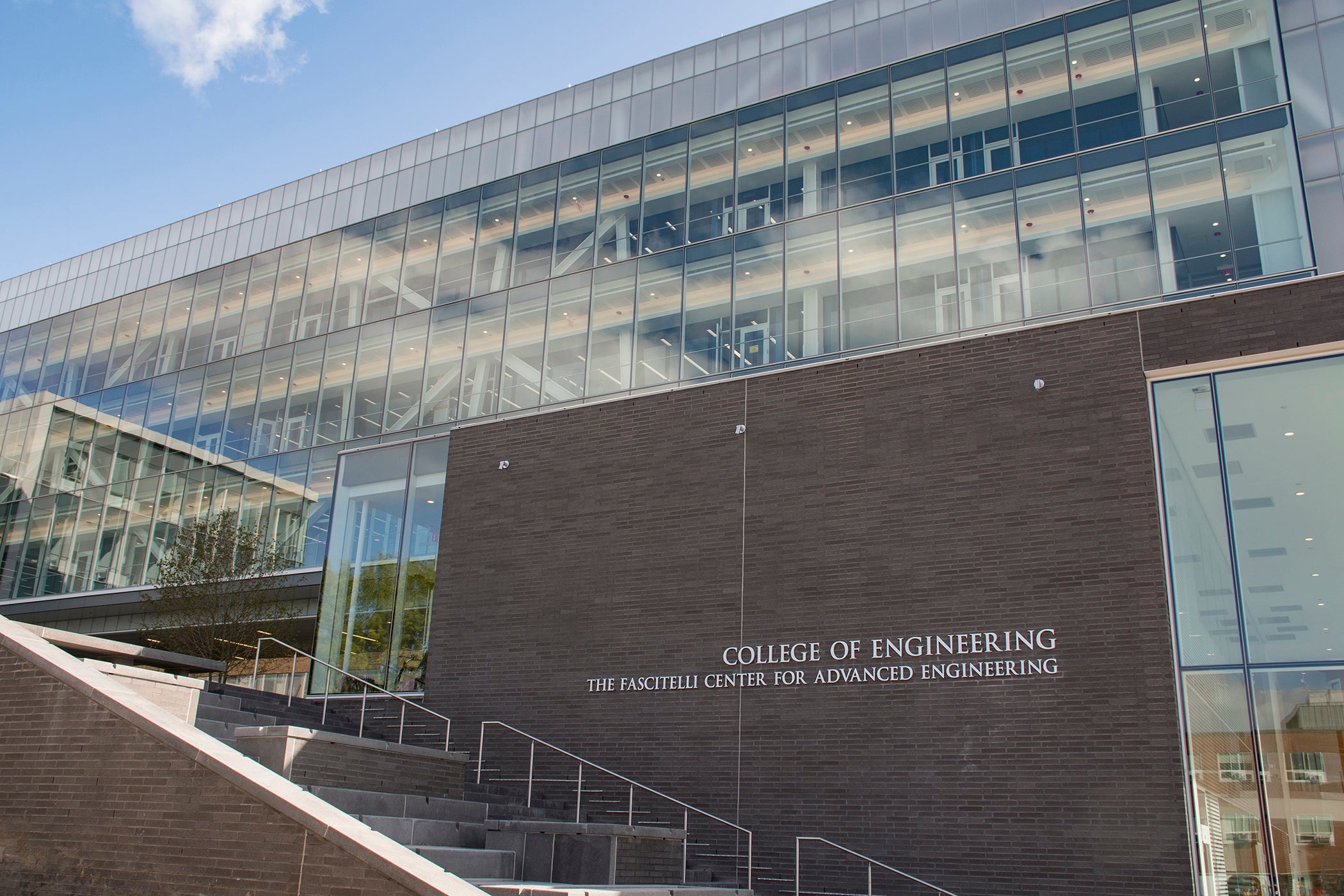KINGSTON, R.I. — October 7, 2019 — More than 500 people joined University of Rhode Island President David M. Dooley and URI College of Engineering Dean Raymond M. Wright today to officially celebrate the opening of what many are calling the most advanced and strikingly beautiful university engineering facility in the country.
U.S. Senators Jack Reed and Sheldon Whitehouse and Congressman David Cicilline, state and University leaders, faculty, staff and URI students and donors crowded The Fascitelli Center for Advanced Engineering to mark this historic day for the University and to thank Rhode Islanders for their support of bond issues totaling $150 million to construct the Fascitelli Center and to expand and renovate Bliss Hall, the historic home of engineering at the University.
Work began on the largest construction project in the University’s history in February 2017, and the Fascitelli Center opened in time for classes in September. Bliss Hall will be ready by November.

During the day, light streams through the walls of glass and into the enormous expanses of open space in the 190,000-square-foot, six-story Fascitelli Center. All of that open, light-filled space was the centerpiece of the design, which University leaders saw as a way to enhance collaboration among faculty and students across all engineering disciplines.
The building’s metal truss support system, which eliminates the need for interior support columns and allows for uninterrupted, open interiors and sleek concrete floors, spans more than 150 feet of open space.
The Fascitelli Center and the improved and expanded Bliss Hall, which first opened in 1928, will strengthen the College of Engineering’s leadership in the areas of clean energy, nanotechnology, robotics, cybersecurity, water for the world, biomedical technology, smart cities, and sensors and instrumentation.
Dooley expressed gratitude to Rhode Island voters for supporting the two bond issues that made the project possible.
Prior to the event, Gov. Gina Raimondo said, “Today’s opening is a milestone for our state and the University, and I’m thrilled that so many Rhode Islanders united behind this project.”
“This new, state-of-the-art facility will help ensure that URI continues to be a global leader in engineering education for decades to come,” Raimondo said. “There’s no greater investment we can make than in our students and their futures, and I’m excited to see the innovative research and collaborative learning that will result from this unique project.”

“We are deeply grateful to Rhode Island voters and our alumni and corporate donors for continuing to support URI’s position as a global leader in higher education,” Dooley said.
“Increasingly, our engineering students and faculty are not only working in interdisciplinary teams within the College, but with students and faculty from across the University in oceanography, health, pharmacy, chemistry, computer science and business, as well as companies and corporations around the state, region and the world,” the president said.
“This new facility will stimulate collaborative, multidisciplinary learning and research. It will lead to discoveries that we cannot even imagine today,” Dooley added.
“With the opening of The Fascitelli Center and Bliss Hall, students can be educated differently, and researchers can collaborate more easily across disciplines,” Wright said. “This building is designed not just to advocate for, but to stimulate interdisciplinary connections and discovery.
“Our faculty are designing and building the infrastructure modern society relies on, finding innovative ways to harness energy from our sun, ocean and even highways, building new medical diagnostic methods and devices, and racing to ensure every man, woman and child has access to clean, safe water,” the dean said. “From undersea to aerial drones, a new wave of robotics is revolutionizing mobility while nanotechnology promises to deliver big changes in how we fight disease, clean up oil spills and much more.”
Also taking part in the festivities were Michael D. Fascitelli, a 1978 graduate of the College of Engineering and a 2008 honorary degree recipient, and Elizabeth C. Fascitelli, partner of The Goldman Sachs Group Inc., who made a $10 million gift in July to benefit the engineering college. Half of the gift will fund lab and research equipment and the remaining $5 million will establish an endowed fund for the dean’s priorities.
The new facility bears the Fascitelli name in recognition of the couple’s commitment to URI and support of important programs across the University.
“The building is beautiful,” said Michael Fascitelli, a North Providence native. “The talent and innovation coming out of URI Engineering are undeniable.”
Fascitelli credits Wright’s vision of bringing the College’s departments together as the driving force behind the building design.
“Science as a whole has become so much more interactive and the world is changing at such a rapid pace,” Fascitelli said. “You really need that cooperation between disciplines.”
The Fascitelli Center and Bliss Hall will bolster the College’s research efforts already underway with The Pratt & Whitney division of United Technologies, the Naval Undersea Warfare Center, Raytheon Co., and General Dynamics/Electric Boat. The college is also working with Japanese instrumentation firm, Shimadzu Corp., headquartered in Kyoto, as well as Hexagon in North Kingstown.
The Fascitelli Center replaces the 98,000 square feet found in the five outdated engineering structures that were razed to make way for the new facility.
On the ground-level floor, there are two 72-seat active classrooms and a 60-seat active learning classroom. Each of those spaces will contain circular tables and technology that will allow students and faculty members to collaborate. The ground-level floor also has core laboratories, including millions of dollars of imaging and other equipment, and space for a future clean room buildout.
The Quad-level floor has a view of the new Engineering Quadrangle, which features an exterior patio with seating areas. Inside there will be a café made of modern composite materials. It will be the perfect spot for students and faculty to gather and grab a bite to eat or a beverage between classes. The cafe will accommodate approximately 110 people.
A glass-walled space allows observers to see into senior capstone project space for seven engineering programs. The first floor will also house the College’s dedicated student shop. It will also be home to two computer labs and two electronic student centers.
The building adds three floors of research labs, organized around the College’s areas of expertise in materials, biomedical technology, water for the world, cybersecurity, sensors and instrumentation, nanotechnology and alternative energy.
Ninety individual faculty offices will be located on three floors, as well six 12-seat conference rooms and six faculty lounges.
In addition to the new, $125 million Fascitelli Center, historic Bliss Hall is receiving a $25 million renovation. The building was gutted to the steel and stone infrastructure, and all of the windows replaced with historically appropriate modern windows. New plumbing, mechanical, fire prevention and electrical infrastructure are also part of the upgrade. Bliss will also house student organization space, student work rooms and several general assignment classrooms. The Bliss Hall part of the project received about $378,000 in support from the Governor’s Commission on Disability to upgrade building access, including new doorways and a new elevator, with another grant proposal pending.
The projects have enjoyed major support from industry and private donors. In addition to the gift from Michael and Elizabeth Fascitelli, the following contributed at least $1 million to the project: Toray Plastics (America); FM Global; Shimadzu Corp.; Barry Gertz ‘76 and Sandy Gertz ‘86; and Kam Esmail ‘66, M.S. ‘68.
The construction manager is Dimeo Construction Co. of Providence and the architect is Ballinger of Philadelphia.
“The Fascitelli Center is one of the most provocative and technologically advanced engineering buildings in the country,” said Terry Steelman, design principal with Ballinger. “The building is intended to enhance the identity and visibility of the engineering disciplines while creating a vibrant hub of interaction and innovation for the entire URI community. This exciting new facility will be an important catalyst for attracting the best faculty, students and industry partners as the College of Engineering grows in national stature.
“There’s nothing like this facility in our portfolio. It’s unique to URI and I’m really proud of that,” Steelman said.
Today’s student speaker, Robin Hall, who expects to graduate in spring 2020, takes advantage of the Intelligent Control and Robotics Lab in the Fascitelli Center surrounded by unmanned aerial vehicles, robots and computers. Situated on the fourth floor, the robotics lab opens up to an expanse of glass that encloses the exterior hallway. He is inspired by his new academic home.
“Being able to work in this space is an amazing upgrade,” he says. “It’s like a temple.”
URI College of Engineering is on the move
The URI College of Engineering has seen immense growth in enrollment and prestige over the years. Here are some facts:
- Enrollment is up to 1,600, from 900, 5 years ago. The Fascitelli Center for Advanced Engineering will allow that number to reach 1,700.
- URI Engineering has a flagship, dual-degree “global” engineering program, the International Engineering Program, the first of its kind in the country. Students can pursue dual degrees in engineering and a language–Chinese, French, German, Italian, Japanese, Spanish.
- 26% of URI Engineering undergrads are in the International Engineering Program.
- 85% of undergraduates graduate having completed one or more paid internships.
- Minority enrollment is up 240% since 2004.
- More than 90% of graduates are employed or in graduate school within six months of graduation.
- Student / faculty ratio is 11.5 to 1.
- College of Engineering has eight undergraduate programs: Biomedical, civil, electrical, computer, ocean, industrial and systems, mechanical, and chemical.
What is an engineering degree worth? Year after year, engineering jobs are paid the highest average starting salary. According to the U.S. Bureau of Labor Statistics, engineers have a median annual wage of $91,010, and the engineering field projects employment growth of nearly 140,000 jobs over the next decade.
By the numbers
The URI College of Engineering’s $150 million project that resulted in The Fascitelli Center for Advanced Engineering and major upgrades to Bliss Hall required an enormous amount of building materials. Here are some fun facts:
- Aluminum and glass:
- Aluminum curtain wall components (including the mullions, sill and head) weight, 182,000 pounds or 91 tons, which are roughly equal to the weight of a space shuttle.
- Glass, 70,550 square feet or 1.6 acres. If the glass were laid out, it would cover an entire football field.
- 2,300 tons of structural steel, a total of 2,900 pieces
- 5 levels of steel over a 150-foot unsupported truss span
- More than 100 truckloads of steel
- A total of 13,400 cubic yards of concrete
- 14,000 square feet of bricks
- 1 mile of underground electric cable
- 17 miles of fire protection infrastructure (4.39 miles of sprinkler pipe), plumbing and mechanical piping
- 24 miles of interior electrical wire
- 100% LED lighting for energy savings

